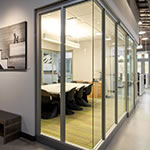In San Juan’s historic Santurce barrio on the northern coast of Puerto Rico, a beautifully preserved, century-old former school looks out toward the main avenue in front of a small plaza. Built in 1904, the structure originally housed the Blanche Kellogg Institute for Women, an institution founded by a relative of the family behind the cereal giant. Following the culmination of the Spanish-American war when Puerto Rico became a US territory, various philanthropic families, in an effort to educate the community, brought a number of initiatives to the island. The school, a missionary initiative, included a chapel along with dormitories.
After the school’s eventual closure and a period of abandonment, the building was later used for government offices and various agencies. It wasn’t until the late 1990s that it was closed completely and sat suffering from neglect. Around 2003, a developer came to the area with a plan for a mixed-use residential and commercial development. Because the building was on the list of historic places, its destruction was not permitted, so the developer built around it.

Due to restrictions in altering the building’s historic exterior, the architects’ new office uses Solatube daylighting systems to bring natural light into the workspace.

Ricardo Álvarez-Díaz
Today, surrounded by that mix of uses, the storied building recently become the new headquarters of architecture and interior design firm Álvarez-Díaz & Villalón (AD&V). Previously renting more typical corporate office space in downtown San Juan, the company—led by Ricardo Álvarez-Díaz and his wife Cristina Villalón—was motivated by the opportunity to continue the unique structure’s preservation and the limitations of their then current environment.
With no control over building air-conditioning or the space’s lighting systems, the firm felt limited. The architects would talk to clients about the advantages of LED lighting or more efficient air-conditioning systems. “They would ask, ‘Well, can you show me?’ and we would [have to explain our situation],” Álvarez-Díaz says. If he and Villalón truly wanted to educate their clients, he says, they would have to develop a space that not only worked for the design firm, but also became a showcase of the sustainability strategies they often recommended to others.
Up and running since June of last year, the firm’s new office is one of a just handful of buildings on the island to achieve LEED certification. What’s more, it is the first architecture office in Latin America to be certified LEED Platinum. “It wasn’t that much more expensive for us to do this,” Álvarez-Díaz says, “and the savings are huge.” The firm spends roughly 40 to 45 percent less on energy than it would in a comparable but less efficient space.

Cristina Villalón
It was the unique opportunity to work with a historic building, including an interior that Villalón describes as “a blank canvas,” that allowed AD&V to simultaneously showcase its three divisions: interiors, green initiatives, and architecture. “There was no need to demolish this beautiful structure and build a modern monster just to satisfy our own ego,” Álvarez-Díaz says. “By using a historic property, we were able to, in a very subtle way, represent who we are as a firm.”
With their sustainability initiatives divided into two divisions, energy conservation measures and responsible sustainable practices, the architects worked to showcase both sides of sustainability, incorporating low-flow appliances that reduced water use by more than forty-five percent and adding high-efficiency air-handling systems and controls, including inverter air-conditioners.
The adaptive reuse brought with it one primary challenge: natural light. According to Villalón, the space’s biggest drawback was that it was relatively dark; the only natural light came in through the front. The architects were not allowed to manipulate most of the building, but they could manipulate the roof, which is how the firm arrived at the idea of solar harvesting. High-efficiency lighting systems by Lutron incorporate occupancy and daylight sensors, and daylight is harvested via Solatube tubular fixtures. “Now the whole space is bathed in natural light,” Villalón says.

The office features state-of-the-art lighting controls by Lutron, which are used to educate AD&V’s commercial clients.
Highest among the implemented sustainable practices is a recycling policy that became a catalyst for the entire complex. Partnering with the local government, the firm also adopted a composting program, which will be implemented into the complex as well. Their intent is to produce zero waste in the coming year.
Aesthetics weren’t comprised. From the get-go, AD&V was determined to dispel the myth “that if you [go green], you have a certain aesthetic that’s not pleasing somehow or has a very granola feel to it,” Villalón says. Designed in the firm’s characteristic modern aesthetic, with pops of color and some industrial hints, “there is nothing granola about this office,” Álvarez-Díaz says.
The firm’s enthusiasm for the space is contagious. “I absolutely love this space,” Villalón says. “I feel very proud that … we can showcase a space that can really sell our philosophy—what we believe in and how we work,” she says. What do they believe? That it is their duty to make more responsible choices, through which they can then help their clients do the same.
“For me,” Villalon says, “the most rewarding [aspect of the project] is that, without having to preach, we’re educating our clients.”

